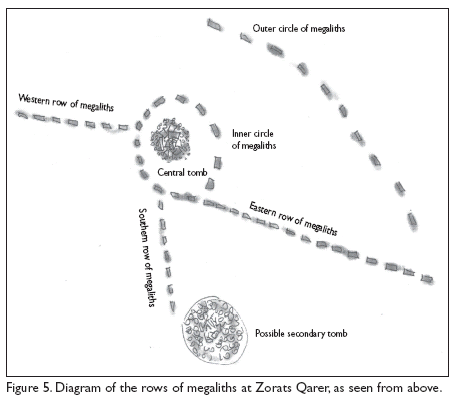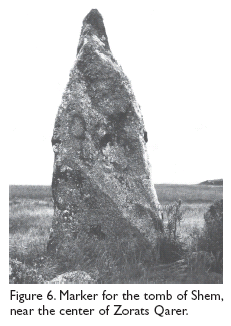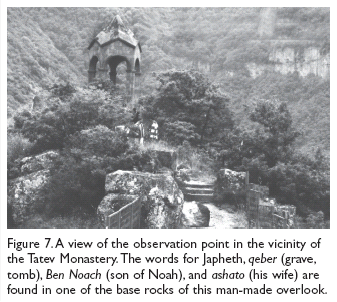- Sep 18, 2006
- 5,024
- 454
- Country
- United States
- Faith
- SDA
- Marital Status
- Single
- Politics
- US-Others
I think this is a scholary article and worth reading and passing along to friends. . Thank-you
Searching for the tombs of Noah’s family
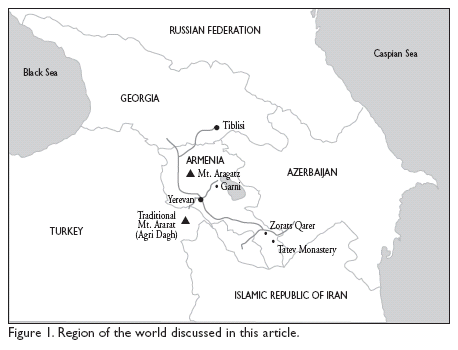
William H. Shea
In the summer of 2003 I participated in a series of Bible conferences for Adventist ministers in Armenia, Georgia, and Southern Russia. While driving north from Yerevan, Armenia’s capital, to Tiblisi, the capital of Georgia, we stopped along the highway to take photographs of Mount Aragatz, the highest mountain in Armenia at 13,419 feet (4.400 meters). This mountain rises about 30 miles (48 km.) north of the traditional location of Mount Ararat, located on the other side of the border with Turkey (see Figure 1, with map of the region).
Bible readers, of course, are acquainted with Mount Ararat in connection with Noah and the Flood, for it was “on the mountains of Ararat” that the ark came to rest as the waters receded (Genesis 8:4, NIV). A few days after the ark rested, “Noah came out [of the ark], together with his sons and his wife and his sons’ wives,” offered a sacrifice of gratitude to God, and settled in the region (vs.18 and ff.). “The sons of Noah who came out of the ark were Shem, Ham and Japheth; and from them came the people who were scattered over the earth” (Genesis 9:18, 19).
After I returned home, I checked on the internet for many close-up views of various locations on Mount Aragatz.1 From a study of these photographs, I was convinced that there were some rock-cut carvings on the southern slope of this mountain just above Lake Qare (about 9,000 ft., 2.700 m.). I wanted to examine these carvings, so I went back to Armenia in June of 2004, accompanied by a professional photographer friend.2
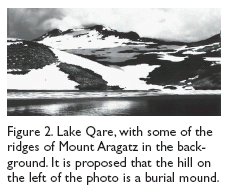 Findings at Lake Qare
Findings at Lake Qare
On June 28, we set out for Lake Qare on Mount Aragatz, accompanied by a guide and our host, the president of the Adventist Mission in Armenia. A decent road runs up to that lake, as the Armenian Institute of Physics studying cosmic rays is located there. After a series of delays, we arrived at Lake Qare and discovered that there was much more snow, ice, and mud than I had anticipated (Figure 2).
Upon arriving at the parking lot at one end of the lake, our guide asked me where I wanted to go. I pointed to the slope of the mountain nearest the parking lot, where I felt we might find some carvings. Instead of following a trail that appeared to be the most direct route to that slope, our companions suggested that we take the other way around the lake. As we reached the far point, I saw a large rock, about 4 x 6 feet (1.2 x 1.8 m.) in size. Approaching it, I noticed the figure of a large snake cut into its upper edge. From this I knew we had made a find, because in the earliest alphabet the snake stands for the letter N (from Semitic nahash = snake). This is also the first letter in the name of the biblical Noah. The rest of the relief and carved inscription can be deciphered as “the dove took wing from the ark here.”
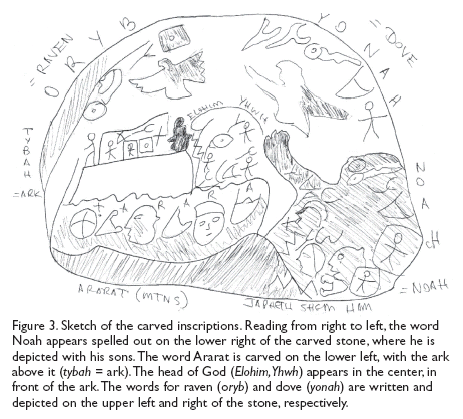
Identification of this first carved stone led to a search for others in the same area. A total of seven carved stones were found within an area of about 25 feet (8 m.) from the first stone. Four of these depict outlines of the heads of various members of Noah’s family—Shem, Ham, Japheth. The men are named in the inscriptions (which must be read right to left) but the women are simply labeled as “wife (ashat) of….”
One of these carved stones is important for determining the nature of the large mound on the other side of the lake. This stone was scored horizontally about two-thirds of the way up, to demarcate the peak. The figure of a man is shown on the right side of this peak. There is a two-word inscription written beside this figure: Noach = Noah and qeber = tomb, grave.
Reading the inscriptions
I first noted the script used here on the other side of the border while visiting the Durupinar formation near Dougbayazit, Turkey, in the summer of 1998. It came as a complete surprise to find a couple of brief alphabetic inscriptions there, since I had previously assumed that any writing found in this area near the landing of Noah’s Ark would be cuneiform. But here it was in an alphabetic script related to Proto-Sinaitic, the earliest written alphabet of mankind, known originally from turquoise mines in Sinai from the mid-second millennium B.C. and more recently from the early second millennium B.C. found in Egypt. Here was an earlier form of that Semitic alphabet found first in Eastern Turkey and now in Armenia.
This stone, with the two-word inscription (Noach qeber = Noah’s tomb), seems to be a model or a marker of the burial mound of Noah that is found across the lake, in plain view of the carved stone. Unfortunately, this interpretation did not occur to me until a couple of months after I returned home.
A larger carved stone located nearest to the edge of the lake shows a more extensive scene that can be deciphered (Figure 3). In the right lower corner is Noah with his hand lifted up as he is shown releasing one of his birds. The dove (yonah) shown above him on the right, while the raven (oreb) is shown in the other upper corner. In the left lower corner opposite Noah, the ark is shown sitting on Ararat. There are faint inscriptions for each one of these features. This scene implies that the mountain upon which the ark landed was this one and not the other one 30 miles to the south.
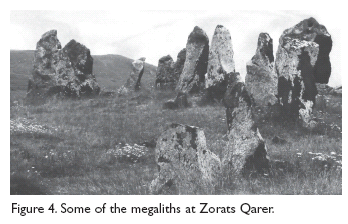
After we had been hiking for a little over an hour, a storm came up. So we had to leave the site prematurely. Nevertheless, we had been able to accomplish more than I expected.
Searching for the tombs of Noah’s family

William H. Shea
In the summer of 2003 I participated in a series of Bible conferences for Adventist ministers in Armenia, Georgia, and Southern Russia. While driving north from Yerevan, Armenia’s capital, to Tiblisi, the capital of Georgia, we stopped along the highway to take photographs of Mount Aragatz, the highest mountain in Armenia at 13,419 feet (4.400 meters). This mountain rises about 30 miles (48 km.) north of the traditional location of Mount Ararat, located on the other side of the border with Turkey (see Figure 1, with map of the region).
Bible readers, of course, are acquainted with Mount Ararat in connection with Noah and the Flood, for it was “on the mountains of Ararat” that the ark came to rest as the waters receded (Genesis 8:4, NIV). A few days after the ark rested, “Noah came out [of the ark], together with his sons and his wife and his sons’ wives,” offered a sacrifice of gratitude to God, and settled in the region (vs.18 and ff.). “The sons of Noah who came out of the ark were Shem, Ham and Japheth; and from them came the people who were scattered over the earth” (Genesis 9:18, 19).
After I returned home, I checked on the internet for many close-up views of various locations on Mount Aragatz.1 From a study of these photographs, I was convinced that there were some rock-cut carvings on the southern slope of this mountain just above Lake Qare (about 9,000 ft., 2.700 m.). I wanted to examine these carvings, so I went back to Armenia in June of 2004, accompanied by a professional photographer friend.2

On June 28, we set out for Lake Qare on Mount Aragatz, accompanied by a guide and our host, the president of the Adventist Mission in Armenia. A decent road runs up to that lake, as the Armenian Institute of Physics studying cosmic rays is located there. After a series of delays, we arrived at Lake Qare and discovered that there was much more snow, ice, and mud than I had anticipated (Figure 2).
Upon arriving at the parking lot at one end of the lake, our guide asked me where I wanted to go. I pointed to the slope of the mountain nearest the parking lot, where I felt we might find some carvings. Instead of following a trail that appeared to be the most direct route to that slope, our companions suggested that we take the other way around the lake. As we reached the far point, I saw a large rock, about 4 x 6 feet (1.2 x 1.8 m.) in size. Approaching it, I noticed the figure of a large snake cut into its upper edge. From this I knew we had made a find, because in the earliest alphabet the snake stands for the letter N (from Semitic nahash = snake). This is also the first letter in the name of the biblical Noah. The rest of the relief and carved inscription can be deciphered as “the dove took wing from the ark here.”

Identification of this first carved stone led to a search for others in the same area. A total of seven carved stones were found within an area of about 25 feet (8 m.) from the first stone. Four of these depict outlines of the heads of various members of Noah’s family—Shem, Ham, Japheth. The men are named in the inscriptions (which must be read right to left) but the women are simply labeled as “wife (ashat) of….”
One of these carved stones is important for determining the nature of the large mound on the other side of the lake. This stone was scored horizontally about two-thirds of the way up, to demarcate the peak. The figure of a man is shown on the right side of this peak. There is a two-word inscription written beside this figure: Noach = Noah and qeber = tomb, grave.
Reading the inscriptions
I first noted the script used here on the other side of the border while visiting the Durupinar formation near Dougbayazit, Turkey, in the summer of 1998. It came as a complete surprise to find a couple of brief alphabetic inscriptions there, since I had previously assumed that any writing found in this area near the landing of Noah’s Ark would be cuneiform. But here it was in an alphabetic script related to Proto-Sinaitic, the earliest written alphabet of mankind, known originally from turquoise mines in Sinai from the mid-second millennium B.C. and more recently from the early second millennium B.C. found in Egypt. Here was an earlier form of that Semitic alphabet found first in Eastern Turkey and now in Armenia.
This stone, with the two-word inscription (Noach qeber = Noah’s tomb), seems to be a model or a marker of the burial mound of Noah that is found across the lake, in plain view of the carved stone. Unfortunately, this interpretation did not occur to me until a couple of months after I returned home.
A larger carved stone located nearest to the edge of the lake shows a more extensive scene that can be deciphered (Figure 3). In the right lower corner is Noah with his hand lifted up as he is shown releasing one of his birds. The dove (yonah) shown above him on the right, while the raven (oreb) is shown in the other upper corner. In the left lower corner opposite Noah, the ark is shown sitting on Ararat. There are faint inscriptions for each one of these features. This scene implies that the mountain upon which the ark landed was this one and not the other one 30 miles to the south.

After we had been hiking for a little over an hour, a storm came up. So we had to leave the site prematurely. Nevertheless, we had been able to accomplish more than I expected.

